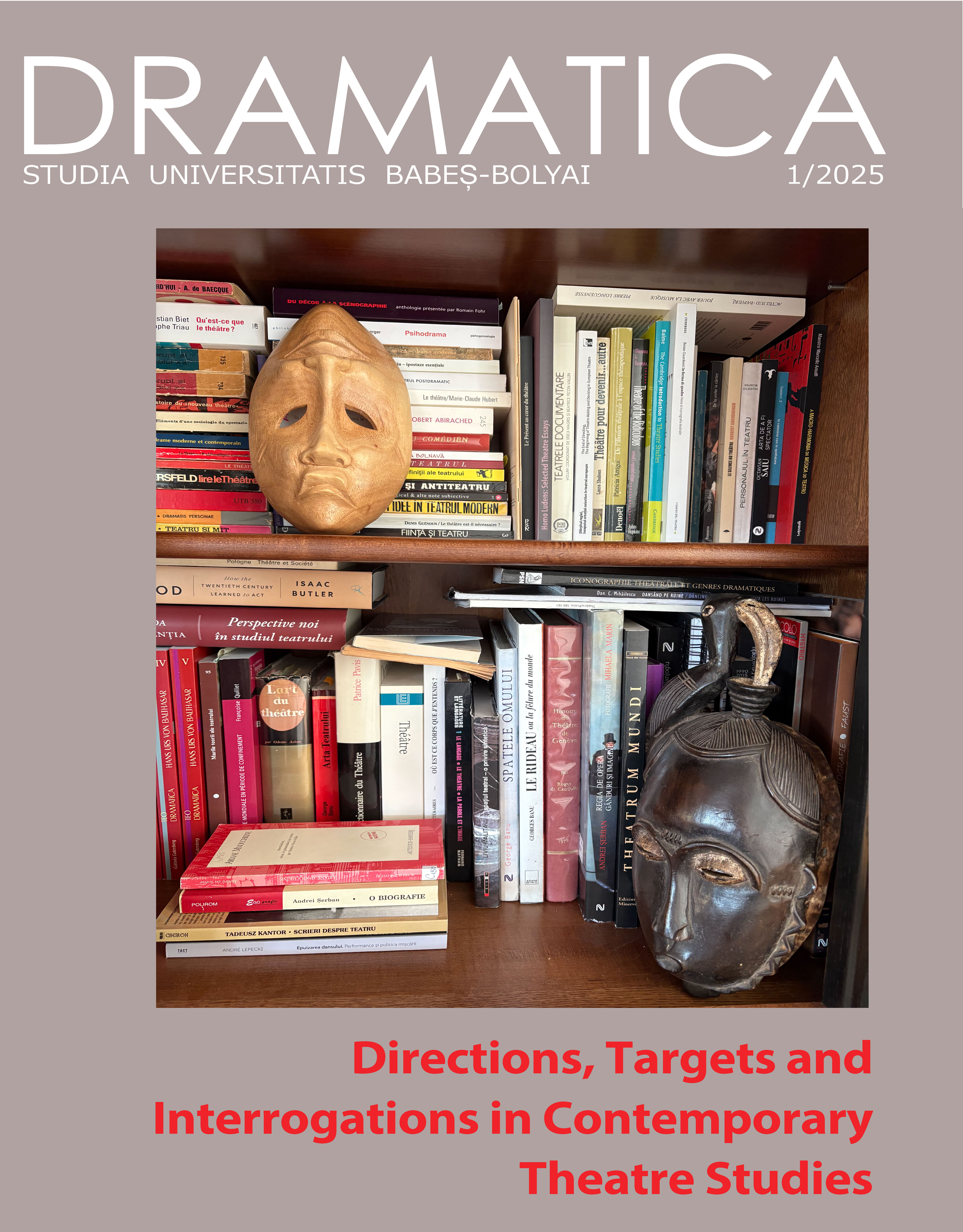Une écologie de l’illusion : technologies et scénographie dans la redéfinition des relations entre humains et non-humains
DOI:
https://doi.org/10.24193/subbdrama.2025.1.03Keywords:
Scenography, Ecology of Illusion, Performance, Exhibition, Technology, Sustainability, Human–Nonhuman RelationsAbstract
This article develops a research I presented at the Technologies symposium of the Prague Quadrennial 2024, an international event dedicated to exploring the relationship between technologies and scenography in live performance and exhibition. My presentation, entitled An Ecology of Illusion, examined how contemporary scenographic practices are redefining the interactions between humans and non-humans. This text extends that exploration by combining theoretical perspectives with concrete case studies, and by highlighting the ways in which scenography can function as a site of ecological awareness, illusion, and transformation.
References
Ouvrages théoriques et critiques
Barthes, Roland. La Chambre claire: Note sur la photographie. Paris : Gallimard, 1980.
Baugh, Christopher. Theatre, Performance and Technology: The Development and Transformation of Scenography. Basingstoke: Palgrave Macmillan, 2014.
Bishop, Claire. Artificial Hells: Participatory Art and the Politics of Spectatorship. Londres : Verso, 2012.
Boal, Augusto. Théâtre de l’opprimé. Paris: Maspero, 1974.
Descola, Philippe. Par-delà nature et culture. Paris: Gallimard, 2005. [Trad. anglaise: Beyond Nature and Culture. Chicago: University of Chicago Press, 2013].
Grau, Oliver. Virtual Art: From Illusion to Immersion. Cambridge, MA: MIT Press, 2003.
Haraway, Donna J. Staying with the Trouble: Making Kin in the Chthulucene. Durham : Duke University Press, 2016.
Ingold, Tim. The Perception of the Environment: Essays on Livelihood, Dwelling and Skill. Londres : Routledge, 2000.
Ingold, Tim. Being Alive: Essays on Movement, Knowledge and Description. Londres: Routledge, 2011.
Ingold, Tim. Être au monde. Quelle expérience commune ? Trad. Sophie Renaut. Bruxelles : Zones sensibles, 2013.
Ingold, Tim. All Art is Ecological. Londres: Penguin Books, 2021.
Kagan, Sacha. Art and Sustainability: Connecting Patterns for a Culture of Complexity. Bielefeld: Transcript Verlag, 2011.
Latour, Bruno. Nous n’avons jamais été modernes. Paris : La Découverte, 1991. [Trad. anglaise : We Have Never Been Modern. Cambridge, MA : Harvard University Press, 1993].
Latour, Bruno. Où atterrir ? Comment s’orienter en politique. Paris : La Découverte, 2017.
Latour, Bruno & Frédérique Aït-Touati. Terrestrial Trilogy. Paris : Éditions B42, 2022.
Lovelock, James. Gaia: A New Look at Life on Earth. Oxford : Oxford University Press, 1979. [Trad. française : Gaïa : une nouvelle vision de la vie sur Terre. Paris : Flammarion, 1993].
Manovich, Lev. The Language of New Media. Cambridge, MA : MIT Press, 2001.
Morton, Timothy. Ecology Without Nature: Rethinking Environmental Aesthetics. Cambridge, MA : Harvard University Press, 2007.
Morton, Timothy. Being Ecological. Londres : Pelican Books, 2018.
Panofsky, Erwin. La perspective comme forme symbolique. 1927. Trad. Guy Ballangé. Paris : Éditions de Minuit, 1975.
Pop-Curseu, Ioan. « Expérimentations optiques et changements de genre dans le théâtre du XIXe siècle », in Théâtres en liberté du XVIIIe au XXe siècle. Genres nouveaux, scènes marginales ?, Actes du colloque international organisé les 31 mai et 1er juin 2013 par Valentina Ponzetto à l’Université de Genève avec le soutien du Fonds National de la recherche Suisse ; publiés sous la direction de Valentina Ponzetto (FNS / Université de Lausanne) avec la collaboration de Sylvain Ledda (CÉRÉdI – EA 3229). Rouen : Publications numériques du CÉRÉdI, "Actes de colloques et journées d'étude (ISSN 1775-4054)", n° 19, 2017, https://publis-shs.univ-rouen.fr/ceredi/436-1.pdf
Articles et rapports scientifiques
Prendeville, Sharon, Chris Sanders, John Sherry & Filipe Costa. “Circular Economy: Is it Enough?” EcoDesign Conference Proceedings, 2014.
Prendeville, Sharon, et al. “Sustainable Design Futures: Circular Economy in the Creative Industries.” The Design Journal 24, no. 2 (2021): 137–152.
Tsao, J.Y., H.D. Saunders, J.R. Creighton, M.E. Coltrin & J.A. Simmons. “Solid-State Lighting: An Energy-Economics Perspective.” Journal of Physics D: Applied Physics 43, no. 35 (2010).
U.S. Department of Energy (DOE). Life-Cycle Assessment of Energy and Environmental Impacts of LED Lighting Products. Washington, DC, 2012.
Spectacles et œuvres cités
Anadol, Refik. Unsupervised. Installation, Museum of Modern Art, New York, 2022.
Campus, Peter. Three Transitions. Vidéo, 1973.
Castellucci, Roméo. Purgatorio. Societas Raffaello Sanzio, 2008.
Colas, Hubert & Patrick Laffont de Lojo. Sans Faim 1. Diphtong Cie, 2004.
Colas, Hubert & Patrick Laffont de Lojo. Sans Faim 2. Diphtong Cie, 2008.
Dumb Type. S/N. Performance multimédia, Kyoto, 1994.
Laffont de Lojo, Patrick. White Out. Installation vidéo, Lux Scène Nationale de Valence, 2017.
Laffont de Lojo, Patrick. Musée des Contradictions. Avec le Collectif Ildieldi, Sophie Cattani & Antoine Oppenheim, 2022–. Présenté aux Alyscamps (Arles) et à Châteauvallon.
Ménard, Phia. Vortex. Performance, 2011.
Random International. Rain Room. Installation, Los Angeles County Museum of Art (LACMA), 2012.
Reynaud, Émile. Le Théâtre optique. Paris, 1892.
Trilogie Terrestre : Inside (2016), Moving Earths (2019), Viral (2020). Conception : Frédérique Aït-Touati & Bruno Latour, avec la complicité de Patrick Laffont de Lojo.
Downloads
Published
How to Cite
Issue
Section
License
Copyright (c) 2025 Studia Universitatis Babeș-Bolyai Dramatica

This work is licensed under a Creative Commons Attribution-NonCommercial-NoDerivatives 4.0 International License.


